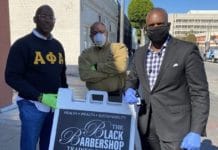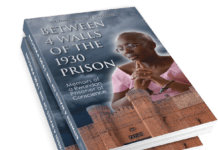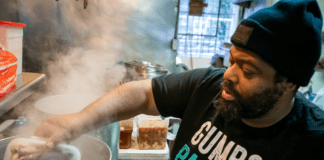by Philip Standing Bear, Indigenous Peoples Media Correspondent

First I would like to introduce myself. My name is Phillip Standing Bear and I am an enrolled member of the Oglala Lakota Sioux Tribe. I would like to say that I feel like it is my duty to protect what is sacred to not just my people, but to all indigenous peoples. I say that with the utmost humility in my heart and mind.
Now let’s get into a little bit of the 3,500 years of documented history of Sogorea Te, or Glen Cove. Glen Cove was a large village and ceremonial grounds that was used by many different tribes throughout the Bay Area. This area has been deemed, declared and even federally recognized as sacred to indigenous peoples. Many Natives alive today have ties to ancestors buried there.
As I was taking pictures of Sogorea Te, I was on the west hill overlooking most of the cove. A lady behind me in one of the expensive homes overlooking the Carquinez Strait, said to me, “Excuse me, do you know that this is private land and that you are trespassing?”
I turned to look at her to see if she knew what she was really talking about. It was an old white lady, maybe in her 60s or early 70s. I looked away, not wanting a confrontation here of all places, and then she asked, “Excuse me, can you speak English?” I looked back at her and told her: “I can speak perfect English. And your backyard is private land; I am not in your backyard.” She tried telling me to tell that to the police when they get here. I then told her that they probably won’t even bother coming, because they have to follow the law like you and I have to.
But Sogorea Te is so much more than an area of land being occupied by indigenous peoples. Rather, it is a sacred place where the people within felt so lost during the colonization period of the Bay Area that they knew they had no more sacred spaces to perform ceremonies and traditions with their ancestors who are buried there. During the missionization of the indigenous peoples of the area, the Native “Christians” were sent to the Mission district of San Francisco. There they lived their Christian lives, “permitted” to visit their homeland twice a year.
Account from Mission, San Francisco: “Twice in the year they receive permission to return to their native homes. This short time is the happiest period of their existence; and I myself have seen them going home in crowds, with loud rejoicings. The sick, who cannot undertake the journey, at least accompany their happy countrymen to the shore where they embark and there sit for days together, mournfully gazing on the distant summits of the mountains which surround their homes. They often sit in this situation for several days without taking any food – so much does the sight of their lost home affect these new Christians.” (Kotzebue [1816] 1932:63, p. 219).
This happens everywhere in the United States of America. Corporations and organizations everywhere ignore the fact that these lands are under federal protection.
According to the United Nations Declaration on the Rights of Indigenous Peoples, Part II, Article 10; The Right to Traditional Space: “Indigenous peoples shall not be forcibly removed from their lands or territories. No relocation shall take place without the free, prior and informed consent of the indigenous peoples concerned and after agreement on just and fair compensation and, where possible, with the option of return.” [Adoption of the declaration on Sept. 13, 2007, was opposed by only four nations: The United States, Canada, Australia and New Zealand. – ed.]
This declaration alone proves that GVRD and the City of Vallejo are ignoring principles agreed to by the great majority of humankind by trying to incorporate the land with their redevelopment plan to place a park with porta-potties on top of a sacred burial site.
I was honored to be introduced to some of the main warriors in the fight to save Segorea Te from development and desecration that culminated in a nearly four-month encampment. They included Corrina Gould, Mark Anquoe and many of other fighters for this land.
As Tiny, Muteado and I pulled up onto Shoal Drive and parked there, we had already noticed how full the area was of people headed to Sogorea Te. As we gathered the equipment out of the back of the snazzy, cherry red, four-door, 2011 Ford-something rental, I could already feel heads turning, looking at the cardboard sign saying “Poor Magazine.” The three of us laughed about it later.

There were many other things that I noticed throughout the ceremonies. I noticed that after almost every song or dance that was performed, an eagle brother called out. He spoke loud and clear, “CAW,” like he was cheering or acknowledging the performers.
All in all, the ceremonies were held in good hearts and souls throughout the community, other than the “rude one,” as I like to call her now. I had the honor of interviewing some Hawaiian sisters that came out to give their blessings, as well as having an interview with another leader of the resistance, Miwok elder Wounded Knee DeOcampo. You can check the video below.
When we left, I at least felt better and more informed about the lifestyles and mindsets of the rich and how it affects the poor. I hope that the public will support Poor Magazine, as well as keep up with me in many more stories to come.
To the braves and feminine braves in the fight for Sogorea Te, I hope to meet and correspond with you in the future for fights over more lands that are being stolen by the industrial complex.
Philip Standing Bear is working with the Indigenous Peoples Media Project on Poor News Network. He can be reached via deeandtiny@poormagazine.org.
From Vallejo to Zimbabwe: The powerful moment in herstory for indigenous peoples everywhere
by Tiny aka Lisa Gray-Garcia, Daughter of Dee

My mama was the orphaned daughter of a landless indigenous Taino and Afrikan father and a displaced indigenous Roma – gypsy – and Irish mother. Removal, displacement, eviction and colonization happened to her indigenous ancestors and it also happened to her. Every day she spent never knowing and yet always longing for her people, her culture, her language and her homelands.
“We have reached a victory for the first time, a precedent setting case for our people, for our ancestors,” said Corrina Gould, a 21st century Ohlone warrior woman who was on the frontline of the struggle for our ancestors at Sogorea Te (Glen Cove). Corrina was talking about a 106-day encampment by indigenous peoples to stop the desecration of a 3,500-year-old ancestral burial ground in Vallejo, California.
“The Greater Vallejo Recreational District wanted to put parking spaces and porta-potties on our burial grounds. That’s when we began a sacred fire and we weren’t going to leave until we knew our ancestors were safe,” Corrina concluded. She went on to explain that, through a complex easement agreement reached between the two tribes in control of the sacred site and the city of Vallejo, the burial grounds were now officially safe from development and desecration.
From Vallejo to Mexico, from Zimbabwe to Hawaii, indigenous peoples have been systematically removed, displaced, bulldozed over, redlined, evicted and gentrified for hundreds of years. Our sacred burial grounds have been desecrated and our farmlands and rivers and medicine have been stolen, sold, poisoned and co-opted, leaving us dependent on governments, NGOs and the non-profit industrial complex to scatter a few crumbs of “aid” our way when it is politically convenient.
The majority of us – post-removal, post Diasporic and without land, resources, safety and even cultural identity like my mama – end up suffering different forms of post-traumatic stress, abuse, economic instability, disability and homelessness or landlessness only to become criminalized, incarcerated and lumped into the collectively unsolvable problem known as “poverty,” so we can be studied, researched, written about and deconstructed by the industry of academia.
The final act of displacement is the removal and desecration of our sacred ancestral burial grounds. In California alone, we have lost countless sacred spaces to shopping malls, parks and museums – our ancestors desecrated so people could sip lattes, buy computer parts and watch Hollywood movies.
There have been tragic losses like the Emeryville and Presidio and Yerba Buena shellmounds located in San Francisco and Oakland. Sorrow-filled, valiant battles were waged by indigenous peoples but, in the end, big money and real estate speculation prevailed as it often does in this capitalist society.
But as the rivers and oceans across Pachamama flow with our spilled blood and stolen resources, we have also reached an extremely important moment in herstory. A moment when centuries of resistance movements brought by threatened, displaced and removed indigenous peoples are prevailing.
“We have been fighting removal for hundreds of years and now another speculator is trying to turn our sacred burial grounds at Rattlesnake Island into a summer vacation home,” said Jim BrownEagle of Lake County Elam people. He went on to explain that his tribal nation has collected extensive documentation of the historic theft of their people’s resources and will proceed with a lawsuit against the government for reparations.
In San Sabastien, Bachajon, Mexico, after a deep struggle by indigenous peoples to control their land and natural resources from government land grabs and destructive “eco-tourism” – a struggle which included false accusation, arrest and incarceration of seven of the indigenous warriors who protect the beautiful waterfalls and rivers of the land – the indigenous peoples prevailed, the political prisoners were released and the truth is circulating throughout international media channels. The fight is definitely not over, but the world is watching and responding and not letting up the pressure on the “bad government” attempts to steal the original peoples’ lands.
Like their brothers and sisters in Chiapas, the Huicholes in Jalisco fought the government’s plan to build a road through their village by coming out and standing in front of the bulldozers and refusing to leave. Now, the government has conceded to the indigenous peoples and is building the road around the village.
Other powerful landless peoples and poor peoples movements that have successfully resisted government politricks and corporate domination recently include the Shackdwellers Union in South Africa, the Landless Peoples Movement in Brazil and the Peoples Parliament in Zimbabwe.
Aligned with indigenous people-led and poor people-led movements across the globe, POOR Magazine has been working on our own form of stolen land resistance we call “HOMEFULNESS,” a sweat-equity co-housing project, practicing equity-sharing and land distribution led by us, the peoples whose voices are continually silenced and repressed: the poor, the displaced, the removed.
As I stood in front of the sacred fire at Sogorea Te, celebrating the last day of this revolutionary victory for our ancestors everywhere, with my fellow indigenous reporters at POOR and PNN, I reflected on the countless fights of indigenous peoples that have come before this one and the ones currently being waged – fights that have a renewed strength now.
“We are part of a pan-Pacific coalition of Samoan, Hawaiian, Tongan and many more Pacific Islander social justice organizers who came together to work on the Free Rapa Nui project,” said Loa Niumeitolu, a Tongan revolutionary who, with her sister, FuiFuiLupe, spoke to us about the work of the Oceana Coalition of Northern California (OCNC) to support the indigenous peoples of Easter Island.
This coalition of Pacific Islanders was one of many nations who came out to stand in solidarity with the Sogorea Te resistance in the occupation. The work of OCNC is based on the fact that many Pacific Islanders are currently incarcerated, displaced and or in poverty through countless forms of indigenous removal and theft.
Other indigenous nations, like the Winnemem Wintu, came with medicine and prayers on the 52nd day of the occupation at Sogorea Te. The homeland of the Winnemem Wintu is centered around the McCloud River in Northern California, which for thousands of years was one of the most fertile salmon-spawning rivers in the West.
In the 1940s, construction of the Shasta Dam resulted in the flooding of Winnemem villages and sacred places and effectively wiped out the McCloud salmon by blocking their upriver passage. The Winnemem are currently battling a proposal to further raise the Shasta Dam and are working passionately to restore their ancestral relationship with Nur, the Salmon. The Winnemem Wintu peoples have committed to standing their ground no matter what, even if the dam is raised, even if the water comes.
“We won this fight because we, as indigenous peoples, as all peoples of all colors and cultures, came together. That’s what we have to do at all of the remaining sites to ensure that they are safe,” said Wounded Knee DeOcampo, Miwok elder who has been fighting for the preservation of ancestral burial grounds for years. “Now that we won this powerful victory we need to focus on the San Francisco Peaks, located in Arizona, another sacred site that must be saved,” DeOcampo concluded.
As the smoke from the sacred fire blended with the sweet smell of sage and tobacco offerings, I placed my Mama Dee and Uncle Al Robles pictures at the entrance to the Sogorea Te prayer circle so their revolutionary indigenous spirits could be part of this important victory.
A quiet softness brushed past me and then I knew. I heard her in the deep beat of the drum and felt her in the soft grass in the wind. Mama was there. Smiling from the deepest place in her wounded heart, as she rarely did, when she saw justice finally done for displaced peoples, like her.
Tiny, aka Lisa Gray-Garcia, poverty scholar, welfare QUEEN, revolutionary journalist, Po’ Poet, teacher and lecturer, is the co-founder with her Mama Dee of POOR Magazine/Prensa POBRE, a poor people-led, indigenous people-led grassroots arts organization dedicated to creating revolutionary media, education and art for and by youth, adults and elders in poverty locally and globally. One of POOR’s many revolutionary media projects is the Indigenous Peoples Media Project . Tiny is the author of “Criminal of Poverty: Growing Up Homeless in America,” published by City Lights. She can be reached at deeandtiny@poormagazine.org. Visit www.tinygraygarcia.com and www.racepovertymediajustice.org.

 Store
Store












